|
Sailing Adventure
Advanced Coastal Cruising to Lake Superior’s Isle Royale National Park
by Tony Green
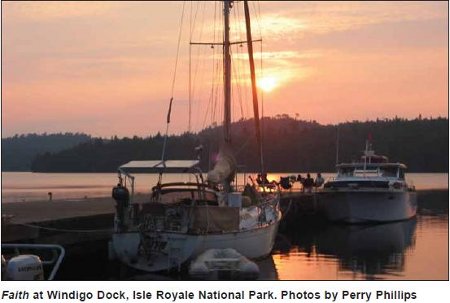
The night crowd at Perkins was somewhat reserved, except for one animated group in a booth by the door. That was us, and there was a certain excitement in the air. Jeff and Sue Erickson, Perry Phillips and I were getting to know each other better before setting out on Faith, the Erickson's 39-foot Fairweather Mariner docked at Barker's Island Marina in Superior, Wisconsin. Actually, I was the only stranger, as Perry, Jeff and Sue had sailed together in the Caribbean the previous winter. We were in Superior to embark on an American Sailing Association Advanced Coastal Cruising course (ASA 106). This advanced sailing class is intended for experienced sailors who own their own boats or have bareboat charter experience. It introduces and develops skills such as voyage planning, night sailing, piloting, dead-reckoning, GPS and radar navigation, spinnaker operations, troubleshooting and casualty procedures. We had no idea sitting at that late-night Perkins table that we would fulfill all of the ASA requirements and then some over the next five days.
Day 1: We arose at 7:30 AM (that's seven bells in the morning watch, for you nautical junkies). Breakfast was on the fly as we tackled the long list of presail tasks under the supervision of Captain Thom Burns of Northern Breezes Sailing School. The morning was a blur of activity to get the boat prepped, watered, fueled, provisioned and rigged for crossing Lake Superior and soon it was time for lunch. We drove into town and stopped at the Anchor Bar in Superior. The menu was mainly burgers and fresh-cut fries, the décor was a blend of northwoods dive and antique shop and the food was excellent. We marveled at how the two employees handled the lunch rush, including cooking and tending bar. People watching was entertaining, as the diners ranged from power-lunching suits to regulars who look liked they'd be attached to their barstools for awhile. I highly recommend the cashew burger. No, it's not some vegetarian concoction made from nuts and tofu; it's a real beef hamburger with cashews on top and it's delicious.
We returned to Faith, finished some last-minute preparations and left the dock at 4 PM with Isle Royale National Park as our destination. Before leaving Barker's Island, we decided to top off the fuel and empty out the holding tank, just to be safe. The trainee at the fuel dock seemed to have some difficulty getting a suction on the holding tank. We didn't get too concerned, since pumpouts are such a routine task done by a simple vacuum system. What could possibly go wrong? We would soon regret not paying closer attention.
We motored out of the Superior Entry and headed northeast across the big lake, with Windigo dock at the southern end of Isle Royale set into the GPS, 145 miles away. The wind was light and from the northeast, so we motored across the lake all night and into the following morning. I hate motoring. I really don't want to talk about it.
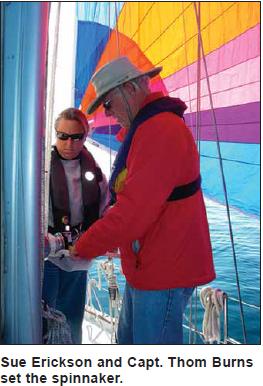
The overnight passage was uneventful, from a shiphandling and navigation standpoint. Seas were calm, shipping traffic was light and the watch routine went smoothly. During the entire northbound voyage, however, the head was hard to operate. Now we were well out in the middle of Lake Superior and it was getting worse. It was more than just friction that a little lubrication would fix. No, this was genuine resistance against the pump handle; perhaps backpressure generated by a blockage somewhere downstream. Alittle troubleshooting confirmed our fears. The holding tank was completely full, the vent was clogged, presumably with waste, and the tank was pressurized. It seemed that our fuel dock trainee at Barker's Island didn't get a good suction on the holding tank and not only didn't remove the waste, but compounded the problem by adding backflush rinse water that also wasn't pumped. Initial repair efforts were met with a steady stream of brown water. I'll leave the rest of the descriptions to the readers' imagination. We were eventually able to vent and contain the overflowing contents, and if any Coast Guard officials are reading this, not a drop went overboard, I swear. This was certainly advanced cruising, but I didn't remember reading about actual head casualties on the ASA skills list.
Day 2: The wind finally picked up and shifted into the east in the afternoon of the second day and we enthusiastically raised the sails. The motor finally fell silent after running almost around the clock (at least our batteries were charged) and Faith heeled over and put on a burst of speed. We quickly closed the gap to Isle Royale and arrived at Windigo Dock at 7 PM after a 27-hour passage. Of course, the service dock was closed for the night, so our holding tank would remain full until the next day. Fortunately, Windigo has modern bathrooms with running water and flush toilets. We were tired and a bit frustrated at the amount of motoring we had to endure, but were happy to finish off the passage with a brisk reach and had a strong sense of accomplishment at having safely crossed the lake. We had a hot meal, good conversation and the night was capped by a stunning sunset over Washington Harbor.
Day 3: We slept in and rested a bit on Isle Royale. The day was as good as it gets in the northern summer; sunny and 75 F, with just enough of a breeze to keep the bugs off the dock. Windigo is a beautiful and interesting spot and we played tourist for most of the morning. The dock is at the end of a long natural harbor and was the headquarters of the Wendigo (sic) Mining Company from 1890-92. The location briefly supported a year-round community of 135 people, but a workable deposit of copper was never found and the mine quickly failed. In the early 1900s, the area was a private hunting retreat for Duluth businessmen. Today's site now hosts a small store and a very nice visitor's center with friendly rangers and the original Fresnel lens from the Rock of Ages Lighthouse. There are several hiking trails, including a short nature walk that goes through a small fenced-in area designed to keep moose out. The difference in height, density and variety of plants on either side of this fence is quite dramatic; evidence of how much vegetation these creatures consume. Wild raspberries and thimbleberries were plentiful and we picked them right from the trail as we walked along. Following our hike, we had a hot shower, then moved Faith over to the fuel dock to get the head pumped out. We warned them that we were absolutely full, although the National Park staff were unflappable. It sure wasn't the first time they've had a cruising boat show up with a bursting holding tank. We left Windigo from the fuel dock at 1:30 PM, headed for Grand Marais on Minnesota's North Shore. This was to be our shortest leg of "only" 50 nautical miles. Winds were 15-25 knots from the west and we flew along under doublereefed main and staysail. The waves gradually grew to 6-8 feet, but seemed much bigger after dark. It was all pretty interesting and even a bit challenging. Little did we know that it was about to get even more exciting.
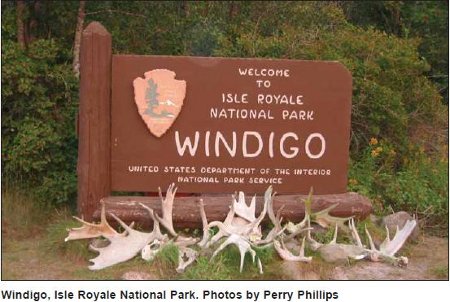
Nobody was particularly hungry for dinner and the boat's motion would have made cooking difficult. The five of us shared a large bag of nacho cheese Doritos in the cockpit as we plowed on through the seas. Perry went down below at about 9 PM to plot our position and make the half-hourly log entry. "There's water down here," rang up from the dark cabin. Lovely. Everyone scrambled to investigate and confirmed that there were indeed several gallons of water at the bottom of the companionway ladder. The water seemed to be coming from the battery compartment under the starboard quarter berth, which was higher than the cabin sole. Water near an electrical power source; this could be fun. Sue, Jeff and Thom stayed topside to operate the boat, while Perry and I began to track down the leak(s) below decks. I guess this was more of the advanced part of Advanced Coastal Cruising. Did Thom plan all this, I wondered? Perry and I simultaneously searched for the leak and cleaned up the water, which by now had mixed with bilge and engine compartment mung to create an oily, stinky mess. We both got an overdose and stayed down too long. Perry went up first and was immediately sick over the side. I was extremely queasy but hung on to my Doritos. We still hadn't found the leak and were running out of places to look. Finally, an abandoned through-hull in the starboard lazarette was discovered to be the source of the water. We couldn't figure out what the fitting was used for, but it was quickly plugged. The crisis was over and we returned the rest of the unwanted water back to the lake as Jeff and Sue added another maintenance and repair item to their growing "To Do" list. I washed my hands several times, but couldn't completely remove the smell and feel of the mung water. Sitting on the windward cockpit coaming, only the fresh breeze in my face kept me from feeding the fish.
During a less-than-perfect tack later that night, the staysail sheets fouled each other and we couldn't free the tangle from the cockpit. The wind was building anyway, so Captain Thom ordered the sail dropped completely. The storm sail was hanked on the stay rather than on a roller furler, so somebody would have to go up on the heaving deck in the dark to get it down. Perry and I volunteered, well aware that a nighttime fall overboard into the cold, rough water could be fatal. We had jacklines run on either side of the deck for this exact situation and the boat was well equipped with harnesses and double tethers. Up we went on deck to lower the stuck staysail. I clipped the longer of the two tethers to the windward jackline and the shorter one to the mast. Thom had taught us to rig tethers so that you could not go overboard if you slipped. Sailors have drowned after falling over the side and then being dragged underwater while still attached to the boat. I shuddered at the thought. The staysail came down easily, but in the process, I turned my back to the wind and waves and lost sight of the dim horizon. My inner ear instantly rebelled and I was overcome with nausea. Since I had rigged my tethers correctly, I was able to get to the leeward lifelines but couldn't quite lean all the way overboard. Two purges later and I felt much better. We decided that is was too rough to remove the sail and carry it back to the cockpit, so Perry and I lashed it to the deck and inner stay with the sheets. We sat on the deck on each side of the sail as we worked, with waves breaking over the foredeck, completely soaking us from the waist down. My legs were getting numb from the cold water and didn't respond well when asked to support my woozy body and stagger back to the cockpit. "I just threw up on your deck," I mumbled, looking at Jeff and Sue. They were good natured about it and were more relieved that the two of us were safe in the cockpit again. Nevertheless, I was a little ashamed at getting sick, but felt good that I had worked through it and helped get the boat out of a tough spot. The seasickness was a first for me in a long time. In the Navy, I made it across the North Atlantic and Pacific Oceans, down to Cape Horn and above the Arctic Circle without getting sick. Queasy, sure, but never lost my Doritos before. Oh well, stuff happens.
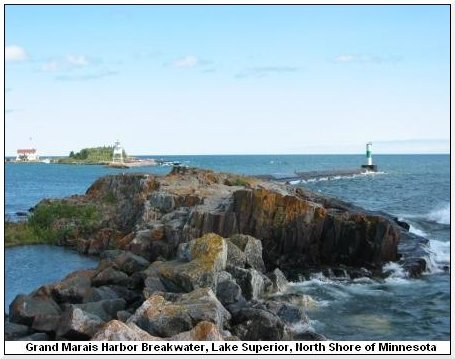
Finally, things seemed under control and it was time to focus on the night approach into Grand Marais. Like most ports from a distance, navigation aids were easily confused with the background lights on shore after dark. Is that the red breakwater light or a stoplight? Neither, it's an automobile tail light. Fortunately, visibility was good and it all made sense as we got in closer. There were a few tense moments when the GPS chartplotter showed us heading too far to the left. Visually, we had the harbor entrance lined up perfectly; red on the right and green on the left and we could see the outlines of both breakwaters. By sight, we were right on track, but the GPS said we should turn to starboard. We were confident of our visual fix and knew that charting software was sometimes inaccurate. After a brief discussion, we held our course and ignored the chartplotter. As Faith split the breakwaters perfectly, her GPS track plotted merrily across the rocks of the eastern breakwater on the display. I understood where the phrase "GPS-assisted grounding" came from.
Grand Marais Harbor was not much calmer than the open lake. There is an anchorage on the west end, which the cruising guide describes as "tenuous at best." There are private moorings and a public dock built by the Forestry Department on the east side. We opted for the sturdy Forestry dock, even though it was exposed to the weather, and tied up just after midnight. It was a rough night at the pier as Faith strained on her mooring lines and we rigged every fender onboard between her port side and the dock timbers.
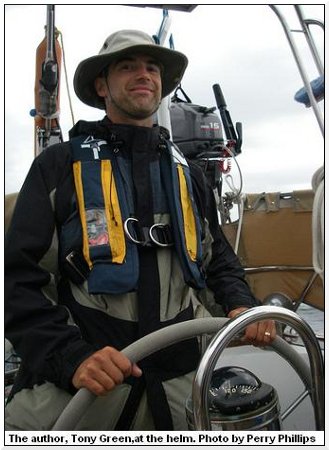
Days 4 & 5: We woke up at about 8 AM. Faith was in one piece, as were we, although the boat had chafed through a ¾-inch mooring line. We walked over to the South of the Border Café for a hearty breakfast of pancakes and omelets. The wind howled at 25 knots from the southwest all morning and continued to batter us against the pier. We spent the day working on boat projects, including rerouting the mainsail reefing lines and lazy jacks. Perry washed down the boat and noticed some orange stains on the port side. "Are those Doritos?" he asked, looking at me. Late in the afternoon, the wind shifted to the west and eased to 10- 15 knots. We decided to eat dinner while we let the lake calm down and made sure that the wind change was for real. We walked over to the Angry Trout Café on the north side of the harbor. Drinks were outside on Adirondack chairs and we got there just in time for the evening otter feeding. We had to wait quite a while for our table, but it was worth it. The fresh whitefish was the best I've ever had and the organic salads and soups were superb as well. The wind remained moderate, and after our dinner digested a bit, we got underway from Grand Marais at 11 PM. The moonlight and visibility were good, but not great, and we picked our way out of the harbor with a spotlight, dodging boats and mooring balls on the way out. A perfect west wind blew at 10-15 knots all night long and we reached down Minnesota's North Shore at 5-6 knots, identifying the lights of familiar landmarks along the way. We rotated in two person watch teams, and Perry and I took the midnight-to-four AM shift. Faith was enjoying the breeze and galloped along through the night. The ride was bumpy, and we were entertained by Jeff and Sue's laughter from below as they were tossed into the air with each big wave. They couldn't sleep, but didn't care and were clearly having fun. Sleep came easily for me, however, and I crashed in the V-berth, half on the bunk cushion and half on the port bulkhead as we remained heeled over hour after hour on a starboard tack. It was a pity to slow down to practice crew overboard drills. When the sun came up, the wind began to ease and shifted to the northwest. We dug through Faith's impressive sail collection and pulled out a lovely cruising spinnaker, complete with dousing sock. We flew the chute until the wind died completely before noon. The lake was calm for about an hour, then the wind swung around and filled in from the southwest. There is a variation of Murphy's Law on Lake Superior that states, "the wind will generally be on the nose when returning to port on the last day of a voyage." I'll bet this happens on other bodies of water. We fired up the diesel for the last several hours and returned to Barker's Island Marina, again through the Superior Entry. We arrived at Faith's slip on E-dock at around 7 PM (two bells in the second dog watch). After offloading and cleaning the boat, we said our goodbyes and headed back to the real world. I had a double ration of snack food to keep me alert on the road. I nibbled on beef jerky, trail mix and chips (no Doritos) as I drove home into the setting sun, thinking "life is good." I had a terrific time, gained some great sailing experience, met some wonderful new people and got seasick. It didn't get any better than that.
Biography: Tony Green has been boating since 1985, including eight years on U.S. Navy nuclear submarines. He currently teaches for Northern Breezes Sailing School and sails with his wife and two daughters on Lake Calhoun in Minneapolis, on the St. Croix River and on Lake Superior
TOP
|